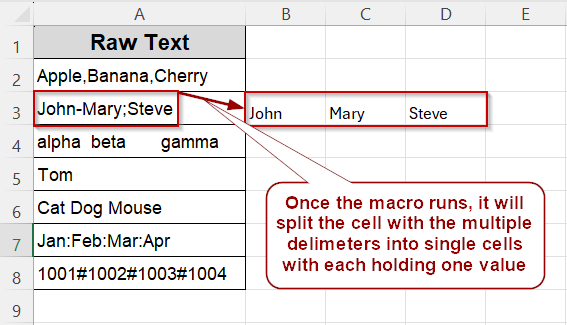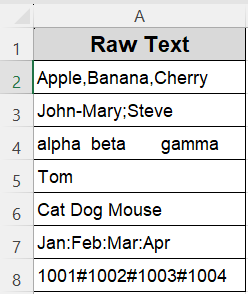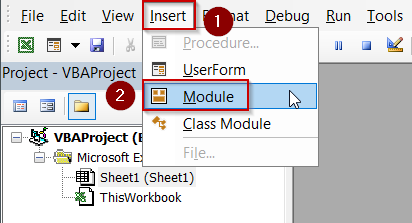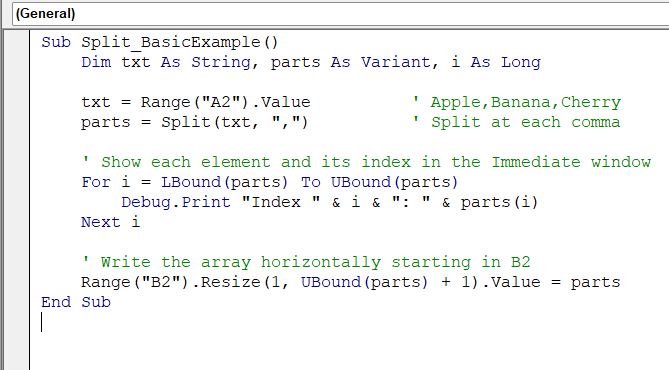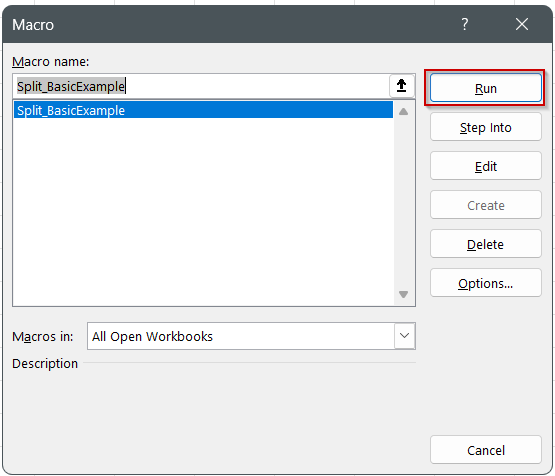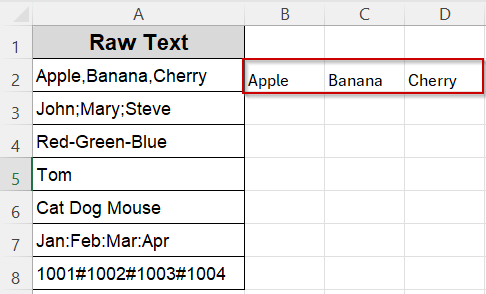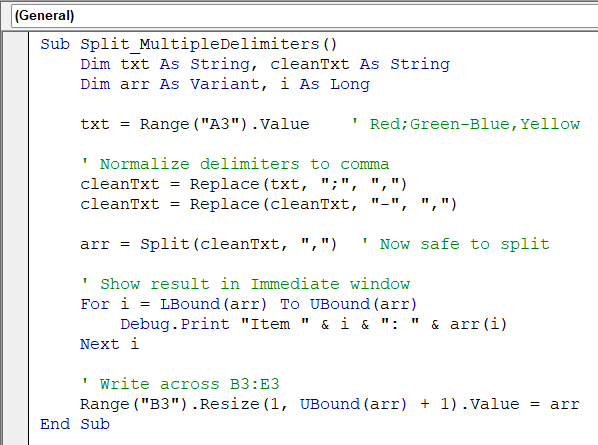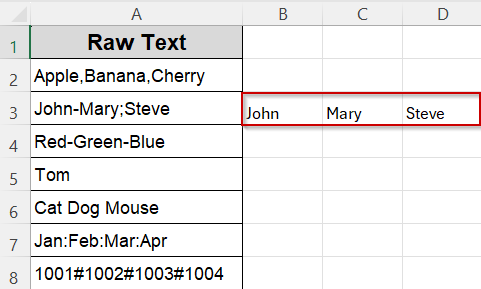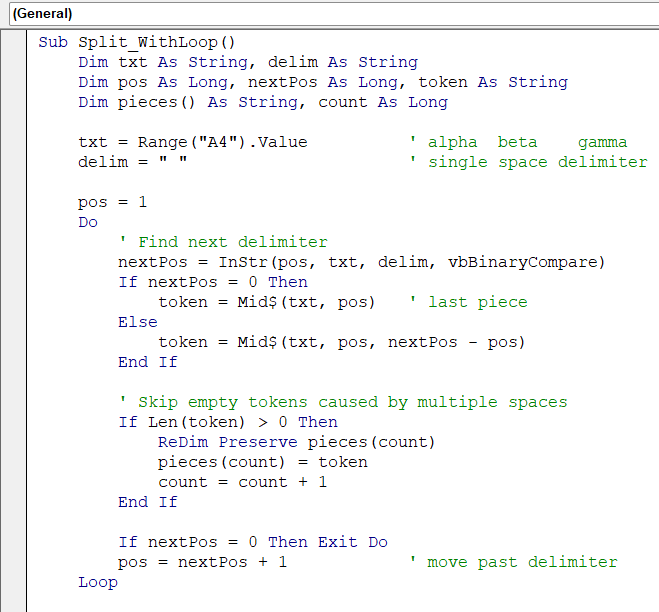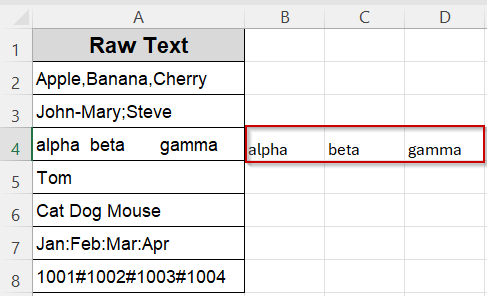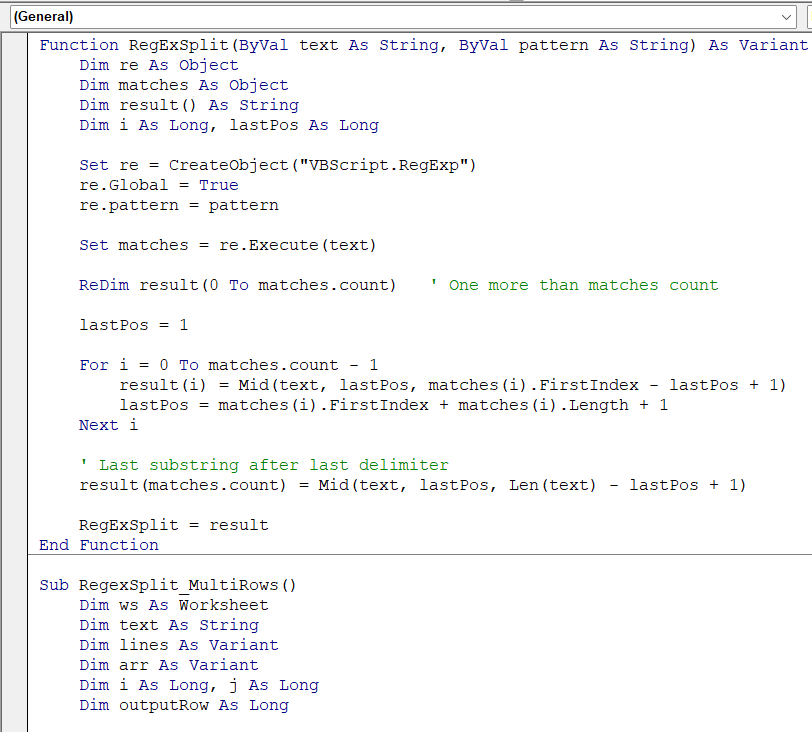Working with text in Excel VBA often means breaking it into parts, for example, separating names, splitting values, or parsing CSV data. That’s where string splitting comes in. VBA gives you several ways to split a string into an array, depending on how complex your needs are.
In this article, we’ll explore different methods to split strings into arrays in Excel VBA, from the built-in Split function to advanced options like regular expressions. You’ll learn when to use each method and how to write clear, reliable code for your string parsing tasks.
Steps to normalize multiple delimiters and split a string into an array in Excel VBA:
➤ Press Alt + F11 , insert a new module, and paste this code:
Sub Split_MultipleDelimiters()
Dim txt As String, cleanTxt As String
Dim arr As Variant, i As Long
txt = Range("A3").Value ' Example: "Red;Green-Blue,Yellow"
' Normalize delimiters to comma
cleanTxt = Replace(txt, ";", ",")
cleanTxt = Replace(cleanTxt, "-", ",")
arr = Split(cleanTxt, ",") ' Now safe to split
' Show result in Immediate window
For i = LBound(arr) To UBound(arr)
Debug.Print "Item " & i & ": " & arr(i)
Next i
' Write results across B3:E3
Range("B3").Resize(1, UBound(arr) + 1).Value = arr
End Sub
➤ Run the macro (F5) with the sample text in cell A3.
➤ The Replace function standardizes all delimiters (semicolon, dash) into commas.
➤ The Split function then divides the cleaned string into array elements using commas.
➤ Results appear in the Immediate Window and fill cells B3:E3 in a row.
Use VBA Split Function to Quickly Convert a Comma‑Separated String
Sometimes your data arrives as one long, comma‑separated list in a single cell, and you need each item individually for further processing. Instead of parsing the text character‑by‑character, you can pass it to VBA’s built‑in Split function, which turns the string into a zero‑based array in a single line.
For this demonstration, we’ll use a worksheet that has cell A2 containing Apple,Banana,Cherry.
The macro will split that text into an array, print each element with its index, and then write the three fruits across cells B2:D2 so you can see the result immediately. This confirms that Split handled the text correctly and that the array is ready for looping or direct output.
Steps:
➤ Press Alt + F11 to open the VBA Editor, then choose Insert >> Module.
➤ Paste the following code:
Sub Split_BasicExample()
Dim txt As String, parts As Variant, i As Long
txt = Range("A2").Value ' Apple,Banana,Cherry
parts = Split(txt, ",") ' Split at each comma
' Show each element and its index in the Immediate window
For i = LBound(parts) To UBound(parts)
Debug.Print "Index " & i & ": " & parts(i)
Next i
' Write the array horizontally starting in B2
Range("B2").Resize(1, UBound(parts) + 1).Value = parts
End Sub
➧ The array’s lower bound is 0, so looping from LBound to UBound safely lists every element.
➧ Dumping the array to a range in one statement is faster than writing cell‑by‑cell, making Split ideal for quick, single‑delimiter parsing tasks.
➤ Return to Excel and press F5 to run the macro.
➤ Check the Immediate window (Ctrl + G) to see the indexed list, and confirm that B2:D2 now show Apple, Banana, and Cherry.
Split Multiple Delimiters Using Replace & Split in VBA
Sometimes your text isn’t clean, one cell might use commas, semicolons, and even dashes as separators. VBA’s Split only accepts one delimiter, but there’s a clever workaround. You can use Replace to convert every unwanted separator into one common one (like a comma), then apply Split.
We’ll convert all three delimiters (;, –, and ,) into commas, then split them into an array of four color names. The result is shown in the Immediate window and also written into cells B3:E3.
Steps:
➤ Press Alt + F11 , insert a new module.
➤ Paste this code:
Sub Split_MultipleDelimiters()
Dim txt As String, cleanTxt As String
Dim arr As Variant, i As Long
txt = Range("A3").Value ' Red;Green-Blue,Yellow
' Normalize delimiters to comma
cleanTxt = Replace(txt, ";", ",")
cleanTxt = Replace(cleanTxt, "-", ",")
arr = Split(cleanTxt, ",") ' Now safe to split
' Show result in Immediate window
For i = LBound(arr) To UBound(arr)
Debug.Print "Item " & i & ": " & arr(i)
Next i
' Write across B3:E3
Range("B3").Resize(1, UBound(arr) + 1).Value = arr
End Sub
➧ This lets you use the normal Split without writing a complex parser.
➧ It's fast, flexible, and great for semi‑structured data like tags or categories scraped from web exports.
➤ Run the macro with F5 , then view B3:E3 and the Immediate window.
Craft Your Own Parser with InStr and Mid to Split a String Manually in VBA
Built‑in functions work for most cases, but sometimes you need surgical control, perhaps you must skip empty tokens, treat consecutive delimiters specially, or handle very large strings more efficiently. By looping through the text with InStr to locate each delimiter and Mid$ to extract the pieces, you can build the array yourself and decide exactly what happens at every step.
For this demo, cell A4 contains alpha beta gamma (words separated by one or many spaces). The macro walks the string, ignores blank segments created by extra spaces, and returns a tidy array of three words. It then prints the result in the Immediate window and writes the words into B4:D4.
Steps:
➤ Press Alt + F11 to open the VBA Editor, then choose Insert >> Module.
➤ Paste the code below:
Sub Split_WithLoop()
Dim txt As String, delim As String
Dim pos As Long, nextPos As Long, token As String
Dim pieces() As String, count As Long
txt = Range("A4").Value ' alpha beta gamma
delim = " " ' single space delimiter
pos = 1
Do
' Find next delimiter
nextPos = InStr(pos, txt, delim, vbBinaryCompare)
If nextPos = 0 Then
token = Mid$(txt, pos) ' last piece
Else
token = Mid$(txt, pos, nextPos - pos)
End If
' Skip empty tokens caused by multiple spaces
If Len(token) > 0 Then
ReDim Preserve pieces(count)
pieces(count) = token
count = count + 1
End If
If nextPos = 0 Then Exit Do
pos = nextPos + 1 ' move past delimiter
Loop
' Display in Immediate window
Dim i As Long
For i = LBound(pieces) To UBound(pieces)
Debug.Print "Word " & i & ": " & pieces(i)
Next i
' Write to B4:D4
Range("B4").Resize(1, UBound(pieces) + 1).Value = pieces
End Sub
➧ ReDim Preserve grows the dynamic array one element at a time.
➧ Empty tokens are skipped by testing Len(token) > 0, eliminating blanks caused by consecutive delimiters.
➧ Because you control every loop, you can add rules (e.g., trim, case‑convert, stop after N tokens) that built‑in Split cannot handle, making this DIY parser ideal for tricky input or performance‑tuning on huge strings.
➤ Return to Excel and press F5 to run the macro.
➤ Check Ctrl + G (Immediate window) for indexed output, and confirm B4:D4 displays alpha, beta, gamma.
Use Regex .Split to Handle Complex Patterns and Multiple Delimiters in VBA
Sometimes your string contains multiple different delimiters or complex patterns that the native Split function cannot handle. Using the VBScript Regular Expression object’s .Split method lets you define a pattern for all delimiters and split the string accordingly. This method is perfect for splitting on multiple delimiters at once or using advanced rules like look-ahead or look-behind.
For this demonstration, we’ll split a string containing commas, semicolons, and spaces as delimiters.
Steps:
➤ Press Alt + F11 to open the VBA Editor, then Insert >> Module.
➤ Paste the following code:
Function RegExSplit(ByVal text As String, ByVal pattern As String) As Variant
Dim re As Object
Dim matches As Object
Dim result() As String
Dim i As Long, lastPos As Long
Set re = CreateObject("VBScript.RegExp")
re.Global = True
re.Pattern = pattern
Set matches = re.Execute(text)
ReDim result(0 To matches.Count) ' One more than matches count
lastPos = 1
For i = 0 To matches.Count - 1
result(i) = Mid(text, lastPos, matches(i).FirstIndex - lastPos + 1)
lastPos = matches(i).FirstIndex + matches(i).Length + 1
Next i
' Last substring after last delimiter
result(matches.Count) = Mid(text, lastPos, Len(text) - lastPos + 1)
RegExSplit = result
End Function
Sub RegexSplit_MultiRows()
Dim ws As Worksheet
Dim text As String
Dim lines As Variant
Dim arr As Variant
Dim i As Long, j As Long
Dim outputRow As Long
text = "Apple,Banana,Cherry" & vbNewLine & _
"John-Mary;Steve" & vbNewLine & _
"alpha beta gamma" & vbNewLine & _
"Tom" & vbNewLine & _
"Cat Dog Mouse" & vbNewLine & _
"Jan:Feb:Mar:Apr" & vbNewLine & _
"1001#1002#1003#1004"
lines = Split(text, vbNewLine)
Set ws = ThisWorkbook.Sheets("Sheet1") ' Change sheet name as needed
ws.Cells.Clear
outputRow = 1
For i = LBound(lines) To UBound(lines)
arr = RegExSplit(lines(i), "[,; \-:#]+")
For j = LBound(arr) To UBound(arr)
If Trim(arr(j)) <> "" Then
ws.Cells(outputRow, j + 1).Value = Trim(arr(j))
End If
Next j
outputRow = outputRow + 1
Next i
MsgBox "Splitting complete!"
End Sub➧ The .Split method returns a zero-based array of substrings split by any sequence of these delimiters.
➧ This method cleanly handles multiple different delimiters and consecutive delimiters without creating empty array elements.
➧ The macro processes multiple lines of text, splitting each line into separate values and writing them row-by-row on the worksheet.
➤ Run the macro (F5). The Immediate Window (Ctrl+G) shows each fruit on its own line, split by commas, semicolons, or spaces.
Frequently Asked Questions
What happens if my string has two delimiters in a row when I use Split()?
Split returns an empty element for every “missing” value between consecutive delimiters. Loop through the array and skip Len(part)=0 items, or use a custom loop/RegExp to ignore blanks.
Can I split on several different delimiters without writing complex code?
Yes, replace every delimiter with one common character and then call Split. For example:
clean = Replace(Replace(txt, “;”, “,”), “-“, “,”)
arr = Split(clean, “,”)
This handles any number of delimiter types in one pass.
When should I choose a RegExp split over the native Split function?
Use RegExp when you need pattern‑based rules: multiple delimiters in one pattern, look‑ahead/look‑behind, or trimming repeated spaces/tabs. RegExp also lets you ignore delimiter cases or optional symbols.
How do I quickly write a split array back to the worksheet?
Resize a range to the array’s bounds and assign the Variant directly:
Range(“B2”).Resize(1, UBound(arr) + 1).Value = arr
This writes all elements in one operation, far faster than looping cell‑by‑cell.
Wrapping Up
Splitting strings into arrays is a common task in Excel VBA, whether you’re working with CSV data, parsing user input, or breaking apart values for further processing. In this article, we explored four practical methods, from the built-in Split function to powerful RegExp-based splitting, so you can choose the one that best fits your needs. Use simple Split for most tasks, and switch to custom loops when you need more flexibility or control.

